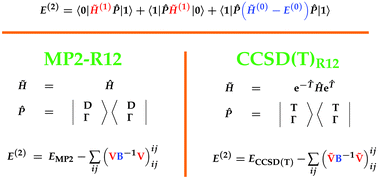Variational formulation of perturbative explicitly-correlated coupled-cluster methods†
Abstract
We present a variational formulation of the recently-proposed CCSD(2)R12 method [Valeev, Phys. Chem. Chem. Phys., 2008, 10, 106]. The centerpiece of this approach is the CCSD(2)R12 Lagrangian obtained via Löwdin partitioning of the coupled-cluster singles and doubles (CCSD) Hamiltonian. Extremization of the Lagrangian yields the second-order basis set incompleteness correction for the CCSD energy. We also developed a simpler Hylleraas-type functional that only depends on one set of geminal amplitudes by applying screening approximations. This functional is used to develop a diagonal orbital-invariant version of the  method in which the geminal amplitudes are fixed at the values determined by the first-order cusp conditions. Extension of the variational
method in which the geminal amplitudes are fixed at the values determined by the first-order cusp conditions. Extension of the variational  method to include perturbatively the effect of connected triples produces the
method to include perturbatively the effect of connected triples produces the  method that approximates the complete basis-set limit of the standard CCSD plus perturbative triples [CCSD(T)] method. For a set of 20 small closed-shell molecules, the
method that approximates the complete basis-set limit of the standard CCSD plus perturbative triples [CCSD(T)] method. For a set of 20 small closed-shell molecules, the  method recovered at least 94.5/97.3% of the CBS CCSD(T) correlation energy with the aug-cc-pVDZ/aug-cc-pVTZ orbital basis set. For 12 isogyric reactions involving these molecules, combining the aug-cc-pVTZ
method recovered at least 94.5/97.3% of the CBS CCSD(T) correlation energy with the aug-cc-pVDZ/aug-cc-pVTZ orbital basis set. For 12 isogyric reactions involving these molecules, combining the aug-cc-pVTZ  correlation energies with the aug-cc-pVQZ Hartree–Fock energies produces the electronic reaction energies with a mean absolute deviation of 1.4 kJ mol−1 from the experimental values. The
correlation energies with the aug-cc-pVQZ Hartree–Fock energies produces the electronic reaction energies with a mean absolute deviation of 1.4 kJ mol−1 from the experimental values. The  method has the same number of optimized parameters as the corresponding CCSD(T) model, does not require any modification of the coupled-cluster computer program, and only needs a small triple-zeta basis to match the precision of the considerably more expensive standard quintuple-zeta CCSD(T) computation.
method has the same number of optimized parameters as the corresponding CCSD(T) model, does not require any modification of the coupled-cluster computer program, and only needs a small triple-zeta basis to match the precision of the considerably more expensive standard quintuple-zeta CCSD(T) computation.

- This article is part of the themed collection: Explicit-r12 correlation methods and local correlation methods

 Please wait while we load your content...
Please wait while we load your content...